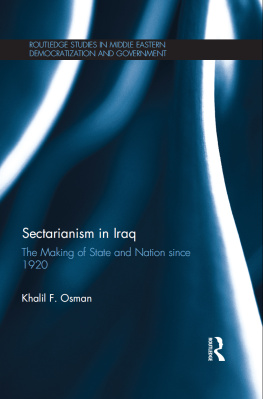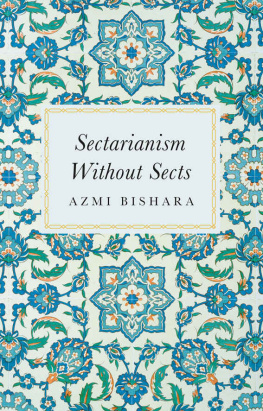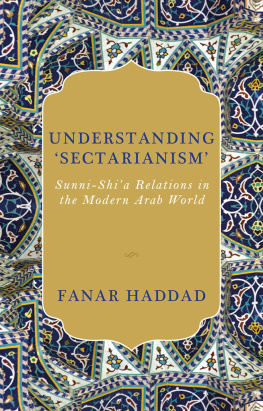AFRICAN ETHNOGRAPHIC STUDIES
OF THE 20TH CENTURY
Volume 79
SECTARIANISM IN SOUTHERN
NYASALAND
SECTARIANISM IN SOUTHERN
NYASALAND
R. L. WISHLADE
First published in 1965 for the International African Institute by Oxford University Press.
This edition first published in 2018
by Routledge
2 Park Square, Milton Park, Abingdon, Oxon OX14 4RN
and by Routledge
711 Third Avenue, New York, NY 10017
Routledge is an imprint of the Taylor & Francis Group, an informa business
1965 International African Institute
All rights reserved. No part of this book may be reprinted or reproduced or utilised in any form or by any electronic, mechanical, or other means, now known or hereafter invented, including photocopying and recording, or in any information storage or retrieval system, without permission in writing from the publishers.
Trademark notice: Product or corporate names may be trademarks or registered trademarks, and are used only for identification and explanation without intent to infringe.
British Library Cataloguing in Publication Data
A catalogue record for this book is available from the British Library
ISBN: 9780815387138 (Set)
ISBN: 9780429488139 (Set) (ebk)
ISBN: 9781138600393 (Volume 79) (hbk)
ISBN: 9780429470967 (Volume 79) (ebk)
Publishers Note
The publisher has gone to great lengths to ensure the quality of this reprint but points out that some imperfections in the original copies may be apparent.
Disclaimer
The publisher has made every effort to trace copyright holders and would welcome correspondence from those they have been unable to trace.
SECTARIANISM
IN SOUTHERN
NYASALAND
R. L. WISHLADE
Published for the
INTERNATIONAL AFRICAN INSTITUTE
by the
OXFORD UNIVERSITY PRESS
LONDON NEW YORK IBADAN
1965
CONTENTS
Oxford University Press, Amen House, London E. C. 4
GLASGOW NEW YORK TORONTO MELBOURNE WELLINGTON
BOMBAY CALCUTTA MADRAS KARACHI LAHORE DACCA
CAPE TOWN SALISBURY NAIROBI IBADAN ACCRA
KUALA LUMPUR HONG KONG
International African Institute, 1965
Printed in Great Britain by
W. & f. Mackay & Co. Ltd., Chatham, Kent
MAP
FIGURES AND TABLES
Map
Figures
Tables
In 1958/59, when I carried out the fieldwork on which this book is based, Nyasaland was the scene of rapid social change. It has since become the independent state of Malawi. This particular change took place while this book was in the press, and the name by which the country was known at the time of this study has been retained.
I am particularly indebted to the many Africans, whose communities and churches are the subject of this book. I am grateful to them for much kindness and hospitality to me while I was living among them as well as for the guidance and information they so generously gave. I also wish to thank members of the British Colonial Service and missionaries working in the area, from whom I received much help and hospitality.
I wish here to acknowledge my gratitude to the International African Institute for the award of a Research Fellowship, which enabled me to undertake the fieldwork and a subsequent period of writing up, and in particular to the Administrative Director, Professor Daryll Forde, for his unfailing help in a variety of ways. I also owe a debt of gratitude to my teachers and colleagues in social anthropology for their comments on the earlier drafts of this book. The responsibility for any faults in it is of course mine and not theirs. Among those who helped me in one way or another in preparing for and carrying out this study, my thanks are especially due to: Dr. R. G. Abrahams, Dr. R. J. Apthorpe, Dr. G. Atkins, Dr. D. G. Bettison, Miss A. Currie, Che Duncan Kasombo, Mrs. M. Lyon, Rev. B. Malekebu, Dr. H. H. Meinhard, Dr. J. M. Middleton, Professor J. Clyde Mitchell, Dr. H. A. Powell, Rev. T. Price, Miss B. Pym, Dr. A. I. Richards, Rev. E. C. Severe, Dr. V. G. J. Sheddick, Professor G. Shepperson, Mr. B. Walker, Dr. P. Worsley.
R. L. WISHLADE
October 1964.
O NE of the characteristics of the major world religions has been (the process of sectarianism by which small new religious groups are formed by secession from existing groups. This differs from the establishment of a new religion inasmuch as the members of the new group, i. e. the sect, still consider themselves followers of the founder of the religion, although asserting their independence from other groups of followers. Sectarianism has been particularly characteristic of the history of Christianity, with the result that there are in the world today several thousand independent religious groups paying allegiance to Christ.
The mixing of peoples of different ethnic origins, as in the United States of America, and the advent of Christian missionaries to many parts of the world inhabited by pre-literate societies, have intensified the process of sectarianism in Christianity over the last century or so. Many new sects have been started by inhabitants of the areas to which missionaries have gone.
In Africa sectarianism is most marked in the Union of South Africa, where it was estimated in 1953 that there were about 2, 000 Christian sects with an entirely African membership.
Although nowhere else in Africa has sectarianism assumed such proportions, African sects have a wide distribution in many parts of the continent. Accounts of them have been written by missionaries, anthopologists, administrators, and others working in West, East, and Central Africa, as well as in the Union of South Africa. My justification for adding to the already considerable literature on African sects is that I shall try to relate them fairly closely to the background of the social organization of the area in which they are found.
The first sect to be established by an African in Nyasaland was the Providence Industrial Mission started by John Chilembwe in 1900. Today there are more than thirty sects in the Southern Province of Nyasaland and it is with some of these that this book is concerned. The African sects in Southern Nyasaland are less spectacular than some of those in other parts of the continent; their members do not wear colourful uniforms or become possessed, and few of them have introduced new doctrines or rituals. Nevertheless I hope to show that an analysis of sectarianism in this area sheds some light on the process of rapid social change which is taking place.
In some parts of Africa, African members of Christian missions have left and started new religious groups, which, although originating with a large content of Christian teaching, have subsequently changed their doctrines, often on the death or banishment of the founder, who then becomes an object of worship. The result is a movement away from the main stream of Christian doctrine. Typically such religious groups are initiated by prophets receiving supernatural revelations.














